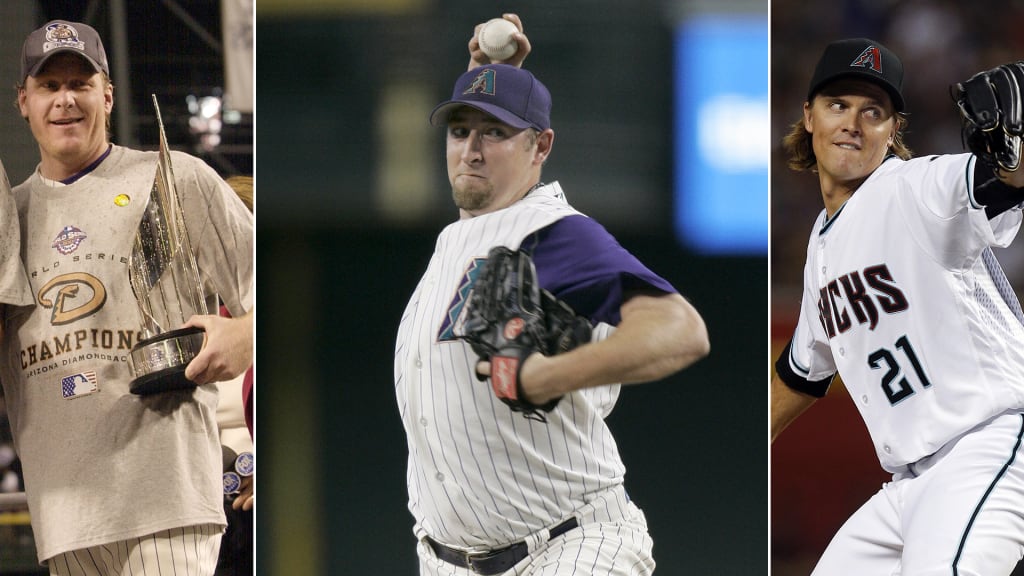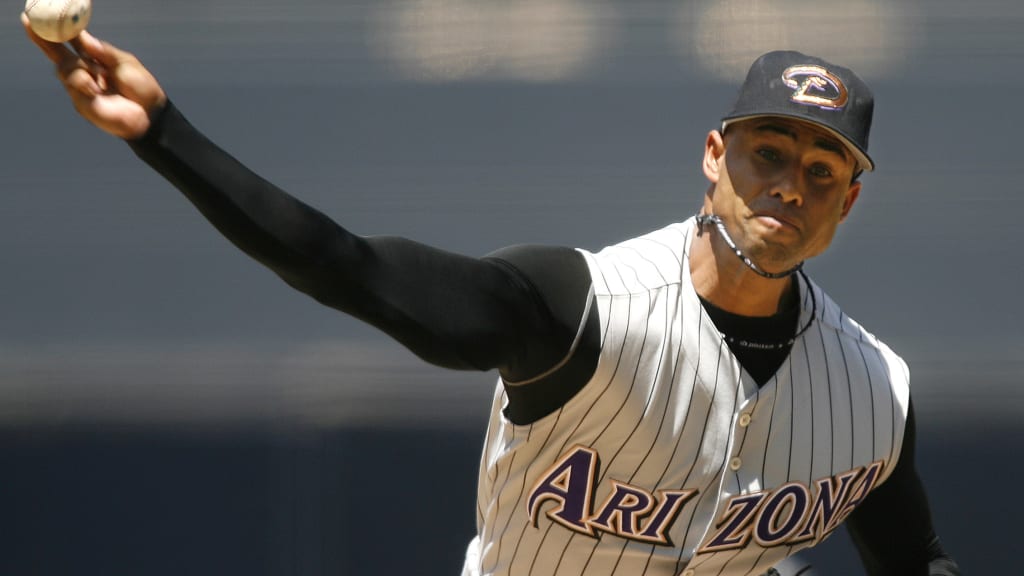
No one loves a good debate quite like baseball fans, and with that in mind, we asked each of our beat reporters to rank the top five players by position in the history of their franchise, based on their career while playing for that club. These rankings are for fun and debate purposes only … if you don’t agree with the order, participate in the Twitter poll to vote for your favorite at this position.
Here is Steve Gilbert’s ranking of the Top 5 right-handed starters in D-backs history. Next week: Left-handed starters.
1) Brandon Webb, 2003-09
Key fact: Leads all D-backs right-handed starters with 33.0 bWAR
Webb and Curt Schilling are clearly 1-2 when it comes to right-handed starters in franchise history and you could make a case for either being No. 1. I went with Webb because of his length of service with the team and the fact that these rankings are supposed to be based on what each player did with the organization -- not on their overall career numbers.
Webb was selected in the eighth round of the 2000 MLB Draft out of the University of Kentucky. Then-scouting director Mike Rizzo said it was his father, Phil, who discovered Webb while scouting another player on the Wildcats.
At that time, Webb had not developed his trademark sinker. He added that to his arsenal after joining the D-backs and burst on the big league scene in 2003. In 29 games (28 starts) that year, Webb had a 165 ERA+ and arguably should’ve won the National League Rookie of the Year Award. Instead, because his record was just 10-9 (wins were still a big deal at that time) he finished third in the voting, behind winner Dontrelle Willis of the Marlins.
Webb won the NL Cy Young Award in 2006, when he had a 152 ERA+, and finished second in the voting the following two seasons, to Jake Peavy and Tim Lincecum, respectively. It was a dominant stretch for Webb, over which he went 56-25 with a 3.13 ERA and a 150 ERA+.
“His sinker is so good he could tell you it was coming and you still couldn’t hit it,” then-catcher Chris Snyder said at the time.
Webb left his Opening Day start in 2009 with shoulder soreness and would never pitch in the big leagues again.
2) Curt Schilling, 2000-03
Key fact: Co-MVP of the 2001 World Series with Randy Johnson
Schilling is likely headed to the Hall of Fame next year, and he had a better overall career than Webb. Schilling just had a shorter stint with the D-backs, which is why he’s second on this list. He was acquired from the Phillies by then-GM Joe Garagiola Jr. prior to the Trade Deadline in 2000 in what was more of a heist than a trade, with the Phils receiving Omar Daal, Nelson Figueroa, Travis Lee and Vicente Padilla.
Schilling was good, not great in 2000, for the D-backs, but he more than made up for that over the rest of his time in Arizona. In 2001-02, he combined to go 45-13 with a 3.10 ERA and a 148 ERA+. Schilling not only racked up the strikeouts, with 609, but he also managed to walk just 72 over that span.
The D-backs don’t win the World Series in 2001 without Schilling. He tossed a pair of complete games against the Cardinals in the NL Division Series, allowing one run over 18 innings. He had another complete game in his lone appearance against the Braves in the NL Championship Series, allowing one run, and he made three starts against the Yankees in the World Series, compiling a 1.69 ERA.
Schilling missed time in 2003 due to an appendectomy and he was dealt after that season to Boston, where he would go on to further establish his Hall of Fame credentials.
3) Zack Greinke, 2016-19
Key fact: Signed to a six-year, $206.5 million deal by the D-backs
When the D-backs signed the 32-year-old in December of 2015 it raised eyebrows in the industry, but the move proved to be a good one, as Greinke went 55-29 with a 3.40 ERA and 131 ERA+ in three-plus seasons with Arizona.
Not only did Greinke perform well for the D-backs, but the organization was able to get out from under most of the two-plus years left on his hefty contract through a Trade Deadline blockbuster with the Astros which also netted Arizona four of the Astros’ top prospects.
4) Dan Haren, 2008-10
Key fact: Led baseball in strikeout-to-walk ratio in both of his full seasons in Arizona
After the D-backs surprisingly won the NL West and advanced to the NLCS in 2007, Haren was acquired by then-GM Josh Byrnes to be the final piece to get the team over the top. While Haren would more than live up to his end of that bargain, the D-backs were not able to repeat their success in '07.
In his first two seasons with Arizona, Haren was remarkably consistent, going 30-18 and compiling a 3.23 ERA while starting 33 games in each season. He had pinpoint command in striking out 429 and allowing just 78 walks over that span.
With the D-backs headed to their second straight last-place finish in 2010, Haren was dealt to the Angels. The deal helped the D-backs in the near term -- lefty Joe Saunders would play a big role on their 2011 postseason team -- and the long run as well, with the team also acquiring top prospects Patrick Corbin and Tyler Skaggs in the trade.
5) Miguel Batista, 2001-03, '06
Key fact: Pitched in relief of Game 7 of the 2001 World Series between starter Schilling and “reliever” Johnson
Batista was blessed with a rubber arm that allowed him to shift between starting and relieving without any negative consequences, and because he pitched in the same rotation as Johnson and Schilling, his contributions tend to get overlooked.
In 2001, Batista appeared in 48 games, including 18 starts, and posted a 139 ERA+ and 11 wins. In two games during the World Series that year, he tossed eight scoreless innings.

